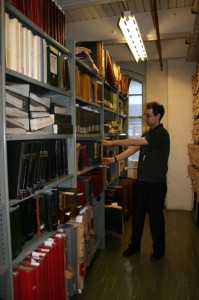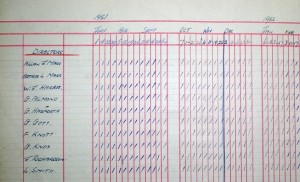I am delighted to announce that work has started on the ‘We ‘Mak’em’ Sunderland Shipbuilding archives project. This is the first in a series of blogs that will report on the project’s progress and highlight any exciting discoveries I make. Background information about the project can be found on our website.
The Sunderland Shipbuilding archives that we hold include a vast quantity of material rescued by our archivists during the shipyard closures in the 1980s. Many of these documents have lain undisturbed on shelves and in boxes for over twenty years. Working on these records is really exciting because I never know what treasures may emerge as I open each box or look along our shelves. I started by sorting through large quantities of unlisted archives from the firm William Doxford & Sons Ltd, which was as well known for the marine diesel engines it produced as it was for the ships it launched.
So far I’ve looked through a lot of operational material relating to the Doxford Engine works including engine particular books, test bed and sea trial records, machinery contracts and engine and machinery specifications. I’ve also uncovered a large quantity of personnel records including officials wages books dating back to 1881 and an apprentice register covering the years 1912-1948.
In mid-July I also found four wage books for an unidentified shipyard. Fortunately, the wage books seem to cover the whole of the yard’s staff from the apprentices through to the directors. With a little investigation I was able to establish that one of the directors listed in the wage book, Allan J. Marr, worked for the shipyard of Sir James Laing & Sons Ltd. I have to admit that this sort of detective work is one of the most enjoyable parts of my job as an archivist.
Once these wage books have been catalogued I’m sure that these will be of great interest to family historians. I am hopeful that these finds are just the tip of the iceberg and I look forward to reporting back with details of more exciting discoveries over the coming months.


32 Responses to Recent discoveries from the Sunderland shipbuilding archives project